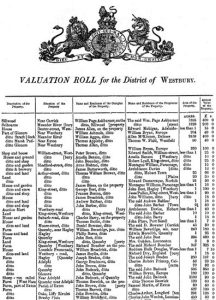Who lived or worked in your building?
Resources such as directories and assessment and valuation rolls can help you find out who else has owned, lived in, or worked in a building, as well as when it was built or what was there before. You can cross check information between resources to help you form a timeline of who owned or lived in your property, and how street names or numbers have changed over time. It may involve a lot of detective work and will be more straightforward for properties in Hobart and Launceston.
Who were the first owners of the land your building sits on?
Our Land Grants guide may help you find the first grantees or purchasers of the land.
Early directories
Online:
- The Hobart Town directory and general guide (1852-1853) Includes geographical listing of residents.
- Middleton & Maning’s Tasmanian directory & gazetteer [1886]-1887? Geographical and alphabetical listing of residents of Hobart and Launceston.
Hobart directories available in the Hobart Reading Room:
- 1825-1829, 1831-1837, 1847, 1852, 1854, 1857, 1859 compiled from individual almanacs, annuals and directories. Later years have geographical listing of residents, while all editions have alphabetical listing.
- Hobart directory, including Sandy Bay and New Town, 1886-87. Includes geographical listing of residents.
For other alphabetical, trade and professional directories and almanacs from 1824 to 1980, see our guide to Directories and almanacs.
For maps showing landholders and sometimes individual buildings, see our guide to Maps and plans.
Tasmania post office directories 1890-1948 (Wise’s)
Tasmania post office directories 1890 – 1948 is a searchable online resource which is usually arranged in three parts: alphabetically by street for Hobart and Launceston and some larger towns such as Burnie; alphabetical lists of residents by town; alphabetical directory of both individuals and business for all of Tasmania; and trade and community directories. To verify you are looking at the right property:
- Note intersecting streets.
- House numbers can change for various reasons, and especially in earlier years there might be no numbering at all, so note the ownership of properties on either side of the property you want to trace, and use these to identify it from year to year.
Assessment and valuation rolls
Published in the Tasmanian Government Gazette up to c.1960, formerly known as Hobart Town Gazette (1825-1880) and Hobart Gazette (1881-1906).
A rates assessment of Hobart properties was done in 1847, but rates were not enacted until the establishment of Municipal Councils in 1852. The earliest Hobart and Launceston valuations occurred between 1853-1855, 1858-1860 and 1862-1863. The Rural Municipal Act of 1858 allowed for the collecting of this information in the country areas as well.

The rolls show:
- When a property first appears and gives the name of the occupant as well as the name of the owner. See ‘Post office directories’ above for more tips on identifying your property.
- Street listings in rolls for Hobart (1847, 1853-1950) and Launceston (1853-1950).
- Alphabetical occupiers’ listings for areas outside Hobart and Launceston.
- A significant change in the rateable value of a property probably indicates subdivision, new construction, demolition or other activity. It can also indicate a revaluation of a whole street. Comparison of values can confirm this.
Assessment and valuation rolls online:
- Assessment roll index : Tasmanian Government Gazette years and page numbers for Assessment Rolls Tasmanian Municipalities 1853-c.1950. Choose a location and year, note the page number, and find it in the online valuation rolls linked below.
- 1853-1890 Hobart valuation rolls in Hobart Town Gazette/Hobart Gazette. Find page numbers of rolls via index above.
- Hobart Town Gazette//Hobart Gazette/Tasmanian Government Gazette 1832-2012. Includes assessment and valuation rolls up to c.1960. Find page numbers of rolls via index above.
Please contact us if you find there any missing issues from our online valuation rolls. We also hold hard copies of indexes and valuation rolls for selected years, as well as microfilm for all years that rolls were published.
Valuation Branch (TA392)
See particularly the Government Valuations 1951-1984 (Archives record series AE298). These are organised geographically by municipality, then by division and street within each municipality.
Land Tax Branch (TA1676)
Series of valuation rolls for various Tasmanian towns for 1946-1957.
Valuation field books, Australian Taxation Office 1923-1964
These records held in the National Archives of Australia provide a comprehensive report on 533 rural Tasmanian properties. Go to Record Search and select “guest” then “Advanced Search”, Select “Series” search. Enter P2134 in series number field and any identifiers you have for the property (owner, property name or location). Digitised copies are available for some properties. Others can be requested from the National Archives Office, Hobart.